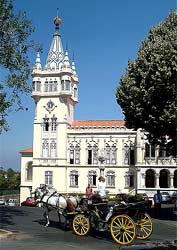Sintra and its history
 Within the reaches of nature, architecture and human occupation, Sintra,its location and its Hills form a nit which today is a singular cultural landscape in the history of Portugal.
Within the reaches of nature, architecture and human occupation, Sintra,its location and its Hills form a nit which today is a singular cultural landscape in the history of Portugal.
Due to the congregation of diverse reasons, amongst which the singular climate provided by the orography of the Hills of Sintra; the fertile lands deposited in the surrounding plains; its closeness to the Tagus stuary and, not to be forgotten, its vicinity – from a given era – to a precociously cosmopolitan but important city and centre of multiple trades (the old Olisippo, probably founded in the Tartessian era during the first half of the first millennium B.C., now Lisbon), the Sintra area was since very early times the aim of an intense human occupation of which traces covering many different eras are visible everywhere.
Thus we can find today, in Sintra and its neighbourhood, a cultural landscape covering practically all the eras of Portuguese history, and revealing evidence of such a size that, due to its importance, has surpassed the limits of this territory.
As such, when Sintra placed its candidature for the UNESCO World Heritage/Cultural Landscape, this did not contain just the classification of a sub-group of historical monuments integrated in a region, but a whole area that since early times adopted an environmental and cultural context with specific characteristics, which comprise ancient and mythical meanings together with ways of life that the current age could aggregate in the heritage it received without destroying its essence.
The sense of such a candidature is thus in line with the historical importance that Sintra assumes in the history of a country of eight hundred years which was one of the first, in Western Europe, to define its borders: a singular culture which has remained intact within a number of reputed palaces and parks; of manors and their nursery gardens and groves; of stately homes and villas in the midst of exuberant vegetation; of extensive fortified walls which crown the highest summits of the Hills. And also several contemplative convents almost lost in the crags, groves and fountains: of churches, chapels and hermitages, all of them ancient pinnacles of faith and art; and finally an intact uniform culture within a vast arraignment of archaeological remains of a millenniums old occupation.
Although the classical buildings and nature constitute the more visible heritage of Sintra, its literary heritage also transformed this area into an almost legendary reference.
The first texts dealing with the Town of Sintra (the Arab Xintara) appear during the Islamic sovereignty, whilst the Greco-Latin authors only made reference to the respective Hills. Sintra is then presented to us (10th century), in a description by a geographer named Al-Bacr, and situated by Al-Munim Al-Himiari as “one of the villages that are dependent from Lisbon in the Andaluz, next to the sea”. Other contemporary texts designate it as the most important urban centre in this region after Lisbon.
In the second half of the 18th century and throughout all the 19th century, Sintra was that mysterious and nostalgic place referred to in foreign guidebooks: the romantic “Glorious Eden of Lord Byron; the “delicate resort” of Almeida Garrett; the “nest of love (where) under the romantic branches noble ladies lost themselves in the arms of poets (…) the strolls in Seteais in the moonlight, over the pale grass, resting in silence for long periods in the Penedo da Saudade (“Cliff of Yearning”), looking over the valley. Under the arch, as if within a heavy frame of stone, in the rich evening light a beautiful picture shone, with an almost fantastic composition, an illustration of a fabulous legend of chivalry and love”, as written by Eça de Queiroz (in “os Maias”); or the alchemical site where Richard Strauss saw, incomparable with “Italy, Greece or Egypt, the true garden of Klingsor – and, up above, the Castle of the Holy Grail”.
For all these reasons, the preservation of Sintra’s cultural landscape was considered as imperative. Heritage defence associations were formed; conferences and festivals under the aegis of Romanticism were organized; old Sintra academies devoted to the Arts and Culture were renewed, and others were founded with the same objectives; the Municipality, reflecting the concerns expressed by the people, developed a comprehensive  cultural policy, mainly directed towards investigation, research and disclosure of the historical and monumental values of the region, for the local enlivenment of the most varied art forms, and for the development of quality minded tourism. New regulations were drafted to protect Sintra and its Hills: sites and monuments were legally classified and thus protected; the Sintra-Cascais Area of Protected Landscape was instituted – now named Sintra-Cascais Natural Park, which includes all the area where the Hills of Sintra are located; official bodies were set up solely devoted to the preservation, restoration and conservation of such a rich Historical and Nature Heritage.
cultural policy, mainly directed towards investigation, research and disclosure of the historical and monumental values of the region, for the local enlivenment of the most varied art forms, and for the development of quality minded tourism. New regulations were drafted to protect Sintra and its Hills: sites and monuments were legally classified and thus protected; the Sintra-Cascais Area of Protected Landscape was instituted – now named Sintra-Cascais Natural Park, which includes all the area where the Hills of Sintra are located; official bodies were set up solely devoted to the preservation, restoration and conservation of such a rich Historical and Nature Heritage.
Research over Sintra during the last one hundred and fifty years has resulted in a voluminous bibliography. As written by Art Historian Victor Serrão in 1989 – “Sintra is not any Town, and it should be made very clear that, with its Hills and its special rusticity it has characteristics which deeply differentiates it from the national pattern – even from the European pattern! It thus demands total respect for its own “homogeneity in diversity”, made up of much diversified communion of styles, ages, cultures, propositions and landscapes – and the responsibility that lies with the authorities involved in this conservation procedure must naturally have cultural vocation as a priority.
As an historical, anthropological and ecological heritage, Sintra is today a site classified as a cultural landscape where, as in the past, lies recognition for both Portuguese and foreign nationals.
